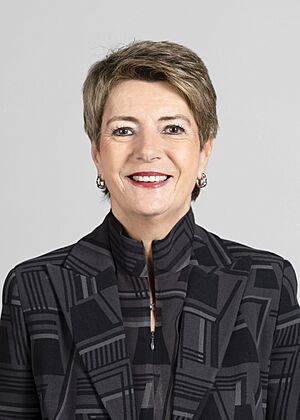President of the Swiss Confederation facts for kids
Quick facts for kids President of the Swiss Confederation |
|
|---|---|
 |
|
| Term length | Unlimited non-consecutive one-year terms |
| Inaugural holder | Jonas Furrer |
| Formation | 21 November 1848 |
| Deputy | Vice President of the Federal Council |
| Salary | CHF 445,163 annually |
The President of the Swiss Confederation is a special role in the Swiss government. This person is like the leader of the Federal Council, which is Switzerland's main executive group. The Federal Council has seven members.
The President is chosen by the Federal Assembly for just one year. They lead meetings of the Federal Council. They also do some important jobs representing Switzerland to other countries.
This President is known as "first among equals." This means they are important, but they don't have more power than the other six members of the Federal Council. Each member, including the President, still leads their own government department. The role of President usually rotates among the council members. The person who was Vice President often becomes President the next year.
The President of the Swiss Confederation is not the country's single head of state. Instead, the entire Federal Council acts as the collective head of state for Switzerland.
The current President is Karin Keller-Sutter. She started her term on January 1, 2025.
Contents
What the President Does
The Swiss President is different from presidents in many other countries, like Austria or Germany. In Switzerland, the Federal Council as a whole acts as both the head of state and the government.
Representing Switzerland
The President handles some duties that a single head of state would normally do. For example, when Switzerland joined the United Nations, Swiss Presidents sometimes spoke at the General Assembly. They speak alongside other world leaders.
However, Switzerland does not have "state visits" where one head of state visits another. When the Swiss President travels abroad, they go as the head of their own government department. When leaders from other countries visit Switzerland, all seven members of the Federal Council welcome them together. Important agreements and documents are signed by the entire Federal Council.
Voting in the Council
Sometimes, there might be a tie vote in the Federal Council. This can happen even with seven members, because members can choose not to vote. Also, meetings can happen without all members present. If there is a tie, the President's vote counts as double. This helps to break the tie.
How the President is Chosen
The President is elected by the Federal Assembly. They are chosen from the members of the Federal Council. The term lasts for one year.
A Rotating Role
In the past, being elected President was a special honor for highly respected Federal Council members. However, some members were sometimes skipped. For example, Wilhelm Matthias Naeff was a council member for 27 years but was President only once.
Since the 1900s, the election is usually not a big surprise. There's an unwritten rule: the Federal Council member who has not been President for the longest time usually gets the job next. This means every council member gets a turn at least once every seven years.
Popularity Test
The main excitement during the election is how many votes the chosen person receives. This is seen as a way to measure their popularity. In the 1970s and 1980s, getting 200 votes out of 246 was considered excellent. Today, with more political disagreements, 180 votes is a good result.
Old Traditions
Until 1920, the President usually also led the Department of Foreign Affairs. This meant that government jobs would shift around every year. The old President would go back to their previous department, and the new President would take over foreign affairs. It was also a tradition for the President not to leave Switzerland during their year in office.
Vice President of the Federal Council
A Vice President of the Federal Council is also elected each year. This person is usually the one expected to become President the following year. This is also an unwritten rule, just like the President's election.
The only official rule is that the President cannot be elected as either President or Vice President for the next year. This ensures that the role keeps rotating among the council members.
See also
 In Spanish: Presidente de la Confederación Suiza para niños
In Spanish: Presidente de la Confederación Suiza para niños


